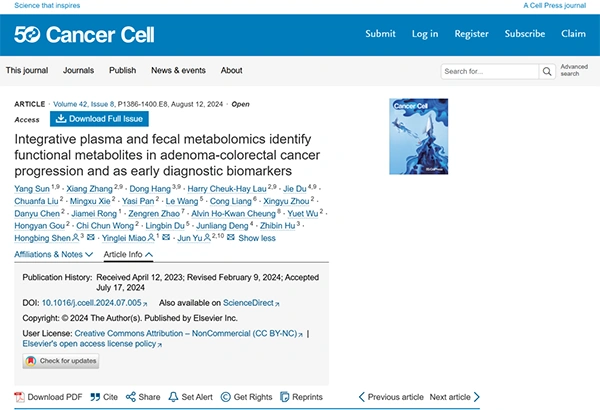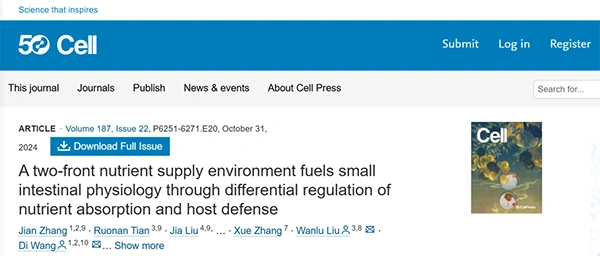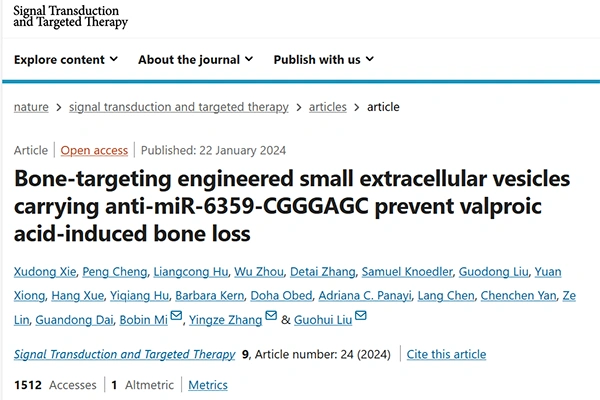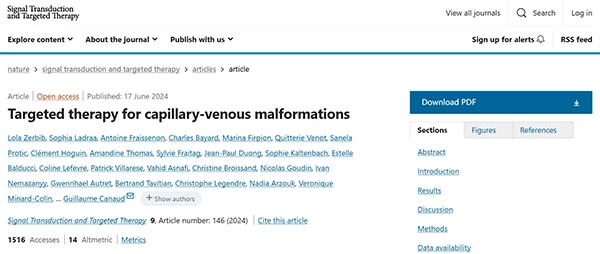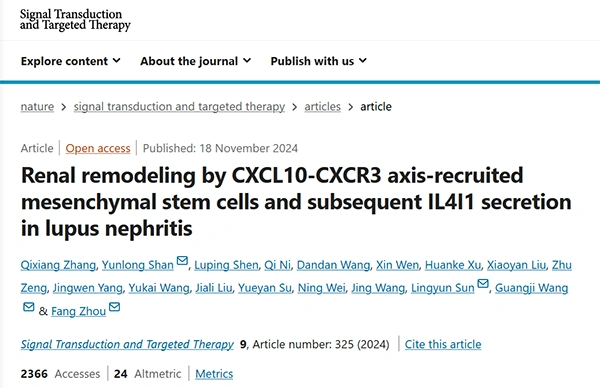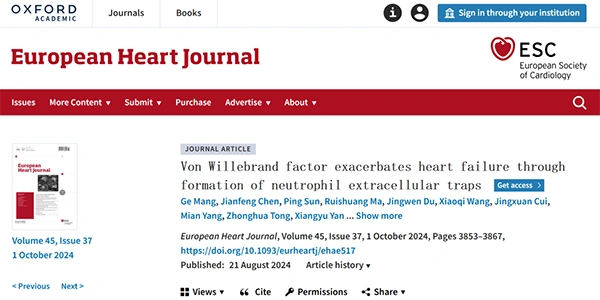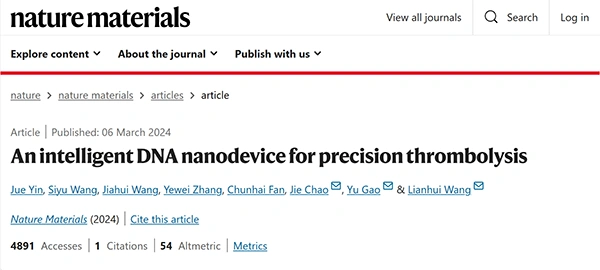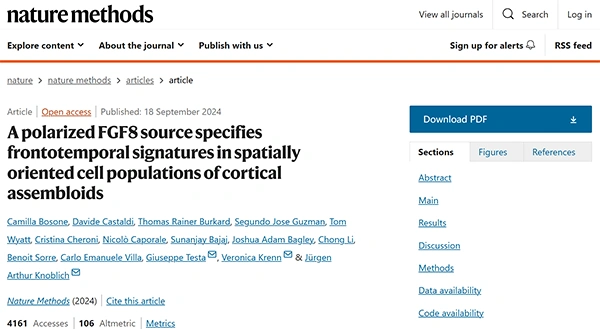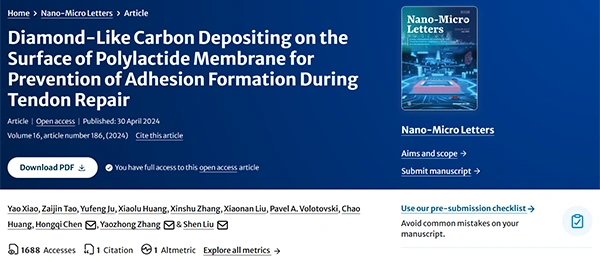CUSABIO has been committed to providing customers with outstanding products and innovative solutions to facilitate breakthroughs in the scientific research field. This year, our products were cited in an estimated 2800 citations, with a cumulative impact factor reaching 12000, and the total number of citations soared to 24000. These figures not only represent the influence of our products but also the culmination of the wisdom and hard work of researchers. Here, we extend our deepest gratitude to every customer who has chosen CUSABIO and look forward to continuing our journey together, creating new chapters in the scientific research field in the coming year. Now let's share our wonderful research results.
2024 Annual Citations Review
01 Integrative plasma and fecal metabolomics identify functional metabolites in adenoma-colorectal cancer progression and as early diagnostic biomarkers
Impact Factor: 48.8
Journal Name: Cancer Cell
CUSABIO Citation Product:
Recombinant Human Alpha-enolase (ENO1);CSB-YP007670HU
Recombinant Human Fragile X mental retardation syndrome-related protein 1 (FXR1);CSB-EP009087HU(A4)
Research Highlights:
This study integrated plasma and fecal metabolomics to identify functional metabolites in the progression of colorectal cancer (CRC) and colorectal adenoma, and explored their potential as early diagnostic biomarkers. The study found that the increase of certain metabolites (such as oleic acid) in CRC is associated with disease progression, while the decrease of other metabolites (such as allocholic acid) is related to disease suppression. These metabolites can directly bind to tumor cell receptors to modulate downstream oncogenic pathways. Clinically, a panel of 17 plasma metabolites was established to accurately diagnose CRC and adenoma. The results highlight the key role of metabolites in CRC progression and demonstrate the potential of plasma metabolites as biomarkers for non-invasive early diagnosis of CRC patients.
02 A two-front nutrient supply environment fuels small intestinal physiology through differential regulation of nutrient absorption and host defense
Impact Factor: 45.5
Journal Name: Cell
CUSABIO Citation Product:
SLC5A1 Antibody;CSB-PA021675LA01HU
Research Highlights:
This study uncovers how the dual-front nutrient supply environment in the small intestine influences intestinal physiology through differential regulation of nutrient absorption and host defense. By tracing macronutrients in vivo and employing spatial metabolomics, researchers have mapped the high-resolution nutrient supply environment of the small intestine, revealing the spatiotemporal dynamics and cell specificity of nutrient absorption. Findings indicate that glutamine from the luminal side supports mucus production, while the serosal side affects the epithelial barrier by modulating fungal metabolites. Irregular eating patterns, such as skipping breakfast, increase the risk of metabolic diseases. The study enhances our understanding of the small intestine's spatiotemporal regulation within its unique nutritional context.
04 Targeted therapy for capillary-venous malformations
Impact Factor: 40.8
Journal Name: Signal Transduction and Targeted Therapy
CUSABIO Citation Product:
Mouse D-Dimer,D2D ELISA Kit;CSB-E13584
Research Highlights:
In this study, a mouse model of PIK3CA-related capillary venous malformations was successfully developed, which accurately mimics the patient phenotype. The malformations were found to be partially driven by the AKT pathway. Alpelisib, a PI3Kα inhibitor, demonstrated significant efficacy in improving capillary venous malformations in both mice and patients. This study supports PI3Kα inhibition as a promising therapeutic strategy for patients with PIK3CA or TEK-related capillary venous malformations. Further clinical studies are necessary to validate and corroborate these findings.
05 Corynebacterium parakroppenstedtii secretes a novel glycolipid to promote the development of granulomatous lobular mastitis
Impact Factor: 40.8
Journal Name: Signal Transduction and Targeted Therapy
CUSABIO Citation Product:
Rat ferritin,FE ELISA Kit;CSB-E08826r
Research Highlights:
This article investigates the pathogenic role of Corynebacterium parakroppenstedtii in granulomatous lobular mastitis (GLM). The researchers confirmed the bacterium's pathogenicity using Koch's postulates and identified a novel glycolipid (named corynekropbactins) secreted by C. parakroppenstedtii, which may promote GLM development by chelating iron, killing mammary cells and other colonizing bacteria, and increasing inflammatory cytokine levels. Additionally, the study analyzed the prevalence of C. parakroppenstedtii infection in patients with GLM and proposed an effective targeted antibiotic treatment strategy. The research highlights the first confirmation of C. parakroppenstedtii as a pathogenic bacterium in GLM and reveals the significant role of its secreted corynekropbactins in the underlying pathological mechanisms.
07 Von Willebrand factor exacerbates heart failure through formation of neutrophil extracellular traps
Impact Factor: 37.6
Journal Name: European Heart Journal
CUSABIO Citation Product:
Mouse ADAM metallopeptidase with thrombospondin type 1 motif, 13 (ADAMTS13) ELISA kit;CSB-EL001301MO
Research Highlights:
This article investigates the mechanism by which von Willebrand factor (VWF) exacerbates heart failure through the formation of neutrophil extracellular traps (NETs). The study found that NET levels are elevated in heart failure patients and mouse models, correlating with deteriorating cardiac function. Mechanistically, NETs impair mitochondrial function in cardiomyocytes by suppressing PGC-1α through the NE-TLR4 pathway. The study also discovered that VWF/ADAMTS13 regulates NET formation via SLC44A2, and the heart failure drug sacubitril/valsartan (LCZ696) can enhance the cardioprotective effects of blocking the VWF-SLC44A2-NET axis. This research establishes the role of the VWF-SLC44A2-NET axis in regulating mitochondrial homeostasis and function, leading to cardiac apoptosis and contributing to heart failure pathogenesis, offering potential new therapeutic targets for heart failure treatment.
08 An intelligent DNA nanodevice for precision thrombolysis
Impact Factor: 37.2
Journal Name: Nature materials
CUSABIO Citation Product:
Rat D-Dimer,D2D ELISA Kit;CSB-E12984r
Research Highlights:
This article introduces an intelligent drug delivery platform based on DNA nanotechnology, designed with an accurate tissue plasminogen activator (tPA) loading system. By integrating DNA nanosheets and responsive DNA lock structures, it achieves precise identification of thrombin concentration in thrombi and on-demand release of tPA. This DNA nano-device has shown significant improvement effects in treating ischemic stroke and pulmonary embolism models, enhancing therapeutic efficiency and reducing side effects, providing new possibilities for personalized precision drug delivery.
09 A polarized FGF8 source specifies frontotemporal signatures in spatially oriented cell populations of cortical assembloids
Impact Factor: 36.1
Journal Name: Nature Methods
CUSABIO Citation Product:
Human Fibroblast Growth Factor 8(FGF8) ELISA Kit;CSB-E15861h
Research Highlights:
This article describes how to engineer human cortical assembloids (polCAs) to model the regionalization of cortical development in the brain. Researchers achieved controlled modulation of FGF8 signaling along the longitudinal axis of the assembloids by fusing an organizer-like structure expressing fibroblast growth factor 8 (FGF8) with an elongated organoid. These polarized cortical assembloids exhibit position-dependent transcriptional programs that partially match in vivo rostrocaudal gene expression patterns and are lost upon mutation in the FGFR3 gene associated with temporal lobe malformations and intellectual disabilities. By producing spatially oriented cell populations with signatures related to frontal and temporal area identity within individual assembloids, this model recapitulates early transcriptional divergence and enables the study of cortical area-relevant alterations underlying human disorders.
10 Diamond-Like Carbon Depositing on the Surface of Polylactide Membrane for Prevention of Adhesion Formation During Tendon Repair
Impact Factor: 31.6
Journal Name: Nano-micro letters
CUSABIO Citation Product:
Rat 8-Hydroxy-desoxyguanosine,8-OHdG ELISA Kit;CSB-E10526r
Research Highlights:
The study presented in the article explores the use of diamond-like carbon (DLC) deposited on polylactic acid (PLA) membranes as a means to prevent peritendinous adhesion during tendon repair. The research demonstrates that the PLA/DLC composite membrane is more effective in preventing adhesion than the PLA membrane alone. The DLC coating enhances the anti-adhesion effect by 23.11% compared to uncoated PLA. The DLC layer on the PLA membranes is shown to effectively reduce the levels of reactive oxygen species (ROS), leading to a decrease in the expression of pro-inflammatory cytokines within the peritendinous adhesion tissue. Additionally, DLC slows down the biodegradation of PLA and the production of lactic acid, which in turn reduces the number of CD68+CD206+ macrophages within the peritendinous adhesion tissue. The study provides a novel therapeutic approach for preventing peritendinous adhesion and expands the scope of application for carbon-based nanomaterials in osteopathic medicine.
As 2024 comes to a successful close, we express our sincere gratitude for the collaboration and achievements of the past year. Looking ahead to 2025, we pledge to continue providing you with outstanding products and services. On the journey of scientific research, CUSABIO is always with you, looking forward to meeting new challenges together and striving side by side for an even brighter future.
24000+ Published Papers!
CUSABIO team. Advancing Together: A Review of CUSABIO's 2024 Annual Citations. https://www.cusabio.com/c-21206.html


